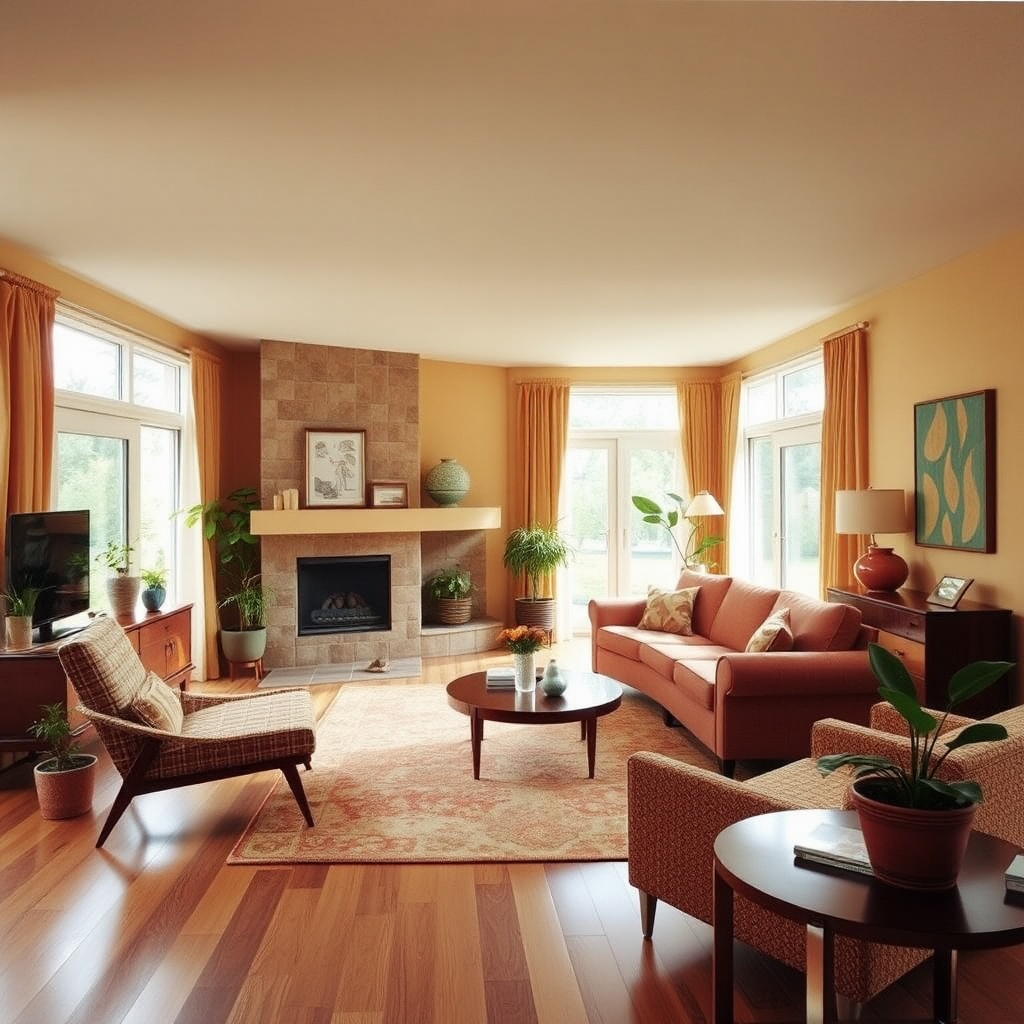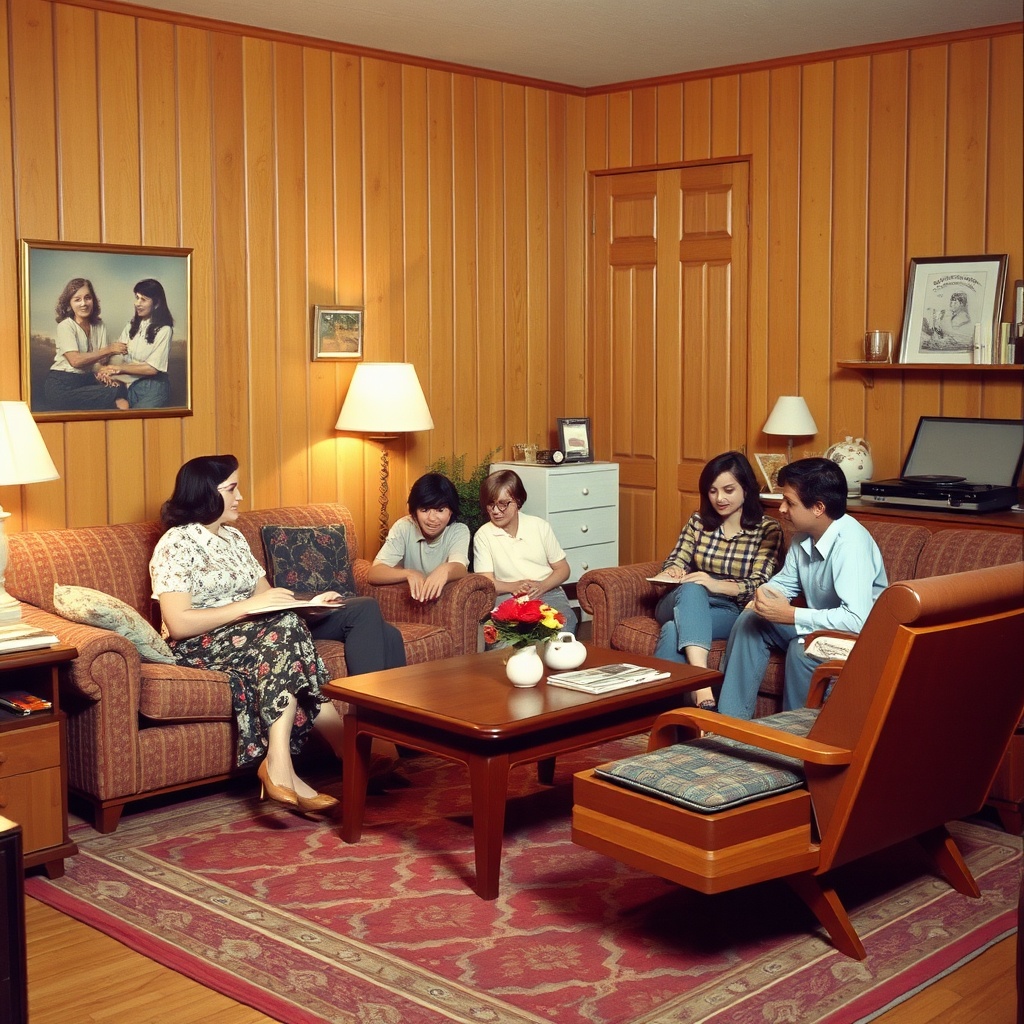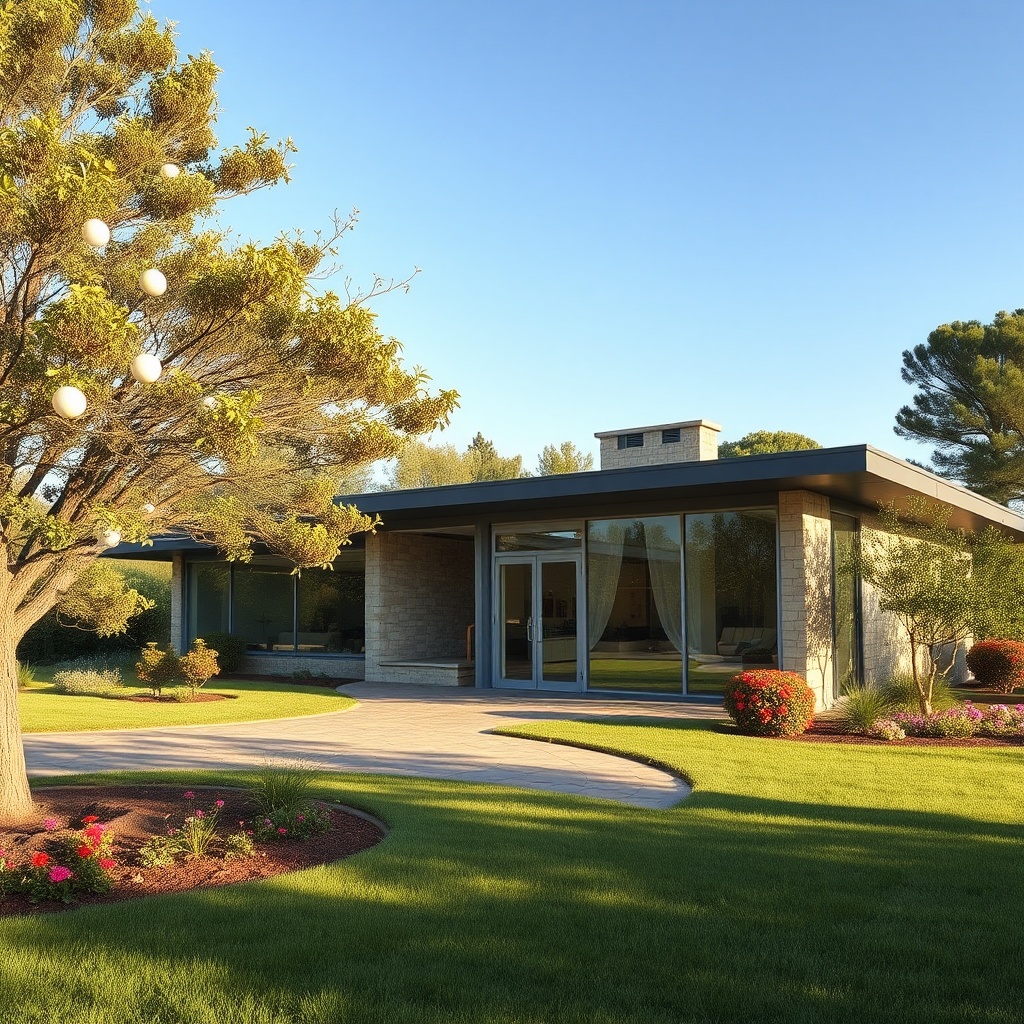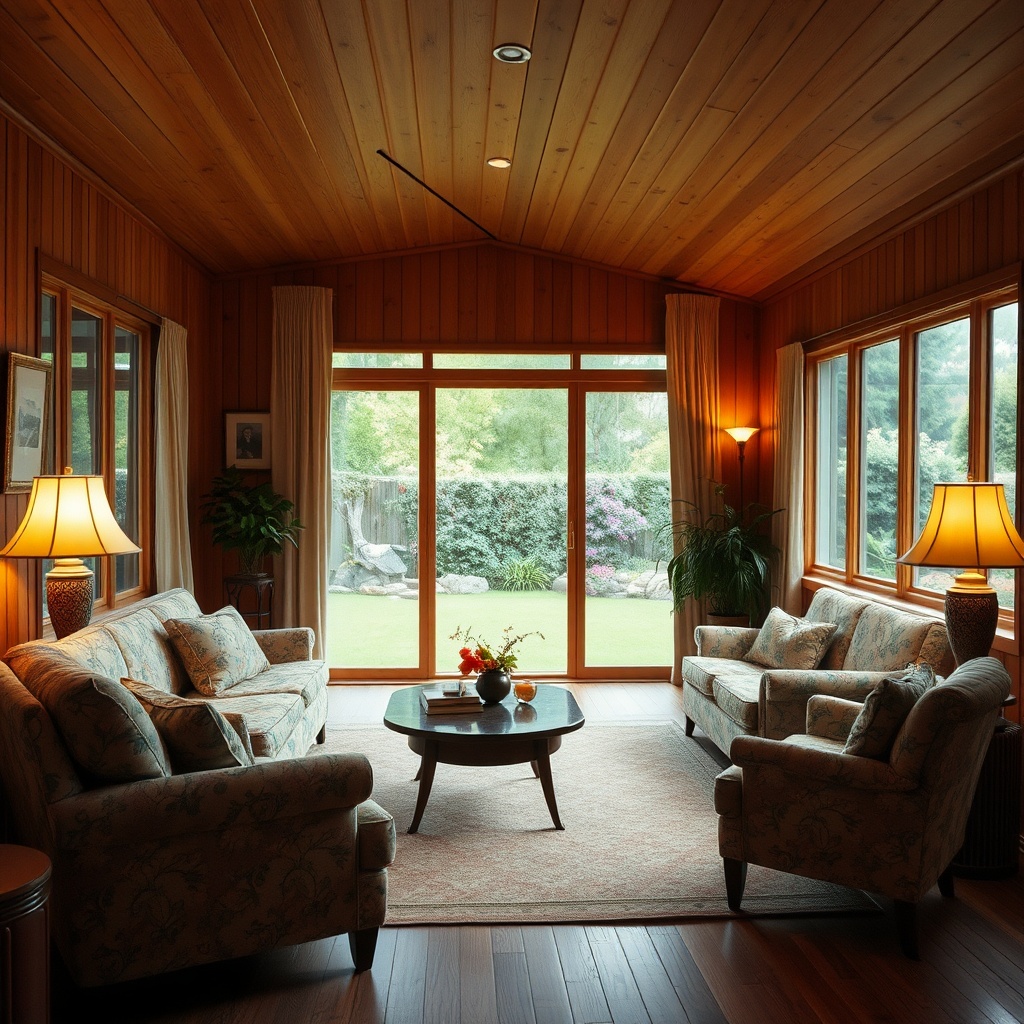Embrace Comfort: The Allure of Open-Concept Living in 1960s Designs

Exploring Open-Concept Living
The 1960s marked a significant shift in home design, particularly with the introduction of open-concept living spaces. This design philosophy emphasizes spaciousness and connectivity, making it ideal for those seeking a comfortable and functional home in their golden years.
Benefits of Open-Concept Living
- Increased Natural Light: Open layouts allow light to flow freely through the home, enhancing mood and vitality.
- Enhanced Social Interaction: The lack of walls encourages gatherings and conversations, perfect for family visits.
- Flexible Space Usage: Adaptable areas can be personalized to meet changing needs, from hobbies to relaxation.
- Ease of Movement: Fewer obstacles mean easier navigation, reducing the risk of falls and promoting independence.
Key Features of 1960s Open-Concept Homes
| Feature | Description |
|---|---|
| Large Living Areas | Spacious rooms that serve multiple functions, combining living, dining, and kitchen spaces. |
| Seamless Transitions | Flowing layouts that connect indoor and outdoor spaces, often with sliding glass doors. |
| Mid-Century Modern Design | Distinctive style characterized by clean lines, organic shapes, and integration with nature. |
| Functional Kitchens | Open kitchens with multi-functional islands perfect for cooking and socializing. |
Creating Your Own 1960s-inspired Open-Concept Space
If you’re considering a 1960s-inspired home, here are some tips to embrace the open-concept lifestyle:
- Choose Light Colors: Soft hues can make spaces feel larger and more inviting.
- Incorporate Multi-Functional Furniture: Look for pieces that serve more than one purpose to maximize space.
- Focus on Flow: Arrange furniture to encourage movement and conversation.
- Enhance with Natural Elements: Bring in plants or natural materials to create a warm atmosphere.
Embracing the allure of open-concept living in 1960s designs can transform your home into a comforting and stylish sanctuary. The principles of this design not only celebrate spaciousness but also foster connections, making it a perfect choice for enjoying life in your golden years.
A Nostalgic Journey: How 1960s House Plans Foster Warm Family Connections

Imagine stepping into a home where every corner tells a story, where laughter resonates through the halls, and where family bonds are woven into the very fabric of the walls. The 1960s house plans invite you to embark on a nostalgic journey, rekindling the warmth of family connections.
The Design Philosophy of the 1960s
During the 1960s, home design embraced open spaces and functional layouts. The focus was on creating environments that encouraged family interaction. Think about:
- Open Floor Plans: Living rooms flowed seamlessly into dining areas, fostering conversation and togetherness.
- Large Kitchens: The kitchen became the heart of the home, where family members gathered to cook, eat, and share stories.
- Outdoor Spaces: Patios and gardens extended the living area, providing a perfect backdrop for family gatherings.
Creating Lasting Memories
In a 1960s style home, the design choices were more than just aesthetic; they were a reflection of a lifestyle that prioritized relationships. Consider how:
- Family Dinners: Remember the joy of gathering around a large dining table? In these homes, shared meals fostered connections.
- Game Nights: Living rooms were designed for comfort, making them perfect for family game nights filled with laughter.
- Seasonal Gatherings: Spacious backyards were ideal for summer barbecues and winter festivities.
Embracing the Charm Today
As you consider your golden years, think about how the charm of 1960s house plans can enhance your life:
- Personalization: Add your unique touch to a classic layout, ensuring it reflects your personality.
- Accessibility: Adaptations can be made to ensure that the home remains a comfortable haven.
- Community Spaces: Engage with neighbors by utilizing outdoor areas for gatherings and social events.
In the end, a home inspired by the 1960s is more than just a structure; it’s a nurturing environment that fosters warm family connections. It’s a place where memories are made, stories are shared, and love is cultivated. Embrace this nostalgic journey as you create a future that honors the past while cherishing the present.
Functional Beauty: Discover the Timeless Features of 1960s Architecture

Introduction to 1960s Architecture
The 1960s marked a significant turning point in architectural design, embracing both functionality and aesthetic appeal. This era is characterized by its innovative use of materials, open floor plans, and a seamless connection between indoor and outdoor spaces. Let’s take a closer look at the timeless features that can enhance your living experience today.
Open Floor Plans
One of the most notable features of 1960s homes is the open floor plan. Unlike the compartmentalized designs of earlier decades, these homes often feature large, flowing spaces that encourage interaction and movement. Imagine walking from the kitchen to the living area without walls interrupting the flow of your space!
Large Windows
1960s architecture celebrated natural light. Homes from this era typically feature large windows that invite sunshine into your living spaces. This not only makes the interiors feel more spacious but also enhances the connection to the outdoors. Picture yourself enjoying a morning cup of coffee while basking in the warm glow of the sun streaming through those beautiful windows.
Natural Materials
Emphasizing the beauty of nature, many 1960s homes incorporated natural materials such as wood, stone, and brick. These elements not only add warmth and character to the home but also create a sense of tranquility and comfort. Consider how a wooden accent wall or stone fireplace could serve as a stunning focal point in your living area.
Innovative Storage Solutions
As we age, having efficient storage becomes essential. 1960s homes often included built-in shelves and cabinets that maximize space without sacrificing style. Think about how easy it would be to keep your belongings organized with these clever designs, allowing you to enjoy a clutter-free environment.
Functional Outdoor Spaces
The 1960s also brought about a focus on outdoor living. Many homes featured patios and decks that extended the living space outdoors. Imagine hosting family gatherings or enjoying peaceful evenings under the stars in your very own outdoor sanctuary. These functional outdoor areas can be perfect for relaxation and socializing.
Mid-Century Modern Influence
The Mid-Century Modern style influenced many 1960s house plans, characterized by its clean lines and minimalist aesthetic. This design philosophy promotes simplicity and functionality, making it easier for individuals to navigate their homes comfortably. Visualize how a minimalist approach can create an inviting and serene atmosphere in your home.
Conclusion: Embracing 1960s Charm
The functional beauty of 1960s architecture offers a timeless appeal that can enhance your golden years. By incorporating these features into your home, you can create an environment that is both beautiful and practical. So, why not consider a touch of 1960s charm in your living space today? The elegance of this era awaits you!
Your Sanctuary Awaits: Creating Cozy Retreats with Vintage Layouts
Introduction to Vintage Layouts
Are you ready to transform your living space into a cozy retreat inspired by the elegant designs of the 1960s? This era introduced innovative layouts that emphasized comfort, simplicity, and functionality. Let’s explore how you can create your own sanctuary with these timeless house plans.
Understanding the 1960s Aesthetic
The 1960s was a decade marked by a unique blend of modernism and vintage charm. The house plans from this era often featured open floor concepts, large windows, and natural materials, making them perfect for creating inviting spaces.
Key Features of 1960s House Plans
- Open Layouts: The seamless flow between rooms encourages interaction and ease of movement.
- Natural Light: Large windows allow for an abundance of sunlight, creating a warm atmosphere.
- Cozy Nooks: Designated areas for relaxation, such as reading corners or sunrooms, enhance comfort.
- Outdoor Integration: Patios and gardens are accessible from main living areas, blurring the lines between indoors and outdoors.
Creating Your Cozy Retreat
To transform your space, consider these steps:
- Choose the Right Layout: Look for house plans that include open spaces, allowing for easy navigation and a sense of freedom.
- Incorporate Natural Elements: Use wood, stone, and plants to bring the outdoors in, fostering a calm environment.
- Personalize with Decor: Add vintage furniture and decor items that resonate with the 1960s style, such as patterned rugs and bold colors.
- Create Comfort Zones: Designate specific areas for different activities, ensuring that each zone feels inviting and comfortable.
Tips for Cozy Living
Here are additional tips to enhance your sanctuary:
- Warm Lighting: Use soft, warm lighting to create a welcoming ambiance.
- Layer Textures: Mix fabrics and textures in your furnishings to add depth and comfort.
- Incorporate Memories: Display photos and mementos from your life to make the space feel personal.
Embrace the 1960s Charm
By embracing the timeless elegance of 1960s house plans, you can create a sanctuary that reflects your personality while providing comfort and tranquility. Start your journey towards a cozy retreat today!
Sustainable Living: Why 1960s House Plans Are Perfect for Eco-Friendly Seniors
Understanding the Appeal of 1960s House Plans
The 1960s marked an era of innovation in home design, with a focus on functionality and simplicity. Many of these houses were built with materials that stood the test of time, making them not just beautiful but also resilient. Imagine living in a home that exudes charm while being practical for your golden years!
Energy Efficiency: A Core Feature
One of the standout features of 1960s house plans is their energy-efficient designs. With large windows that invite natural light, these homes reduce the need for artificial lighting. This not only saves on energy bills but also creates a warm, inviting atmosphere. Consider how you can enjoy the sunlight streaming in while minimizing your carbon footprint!
Using Sustainable Materials
Many houses from the 1960s were constructed with natural materials like wood and brick, which are more sustainable than modern alternatives. These materials are often better insulated, keeping your home comfortable year-round without excessive energy use. Think about the benefits of a home that is as eco-friendly as it is beautiful!
Compact and Efficient Layouts
1960s house plans typically feature efficient layouts that maximize space without unnecessary rooms. This compact design not only makes cleaning easier but also reduces the energy needed for heating and cooling. Wouldn’t it be wonderful to enjoy a cozy space that feels just right for you?
Outdoor Spaces for Gardening
Many homes from this era include gardening spaces, perfect for growing vegetables or flowers. Gardening can be a fulfilling activity that promotes physical health and mental well-being. Picture the joy of tending to your garden while contributing to a sustainable lifestyle!
Community and Accessibility
Homes from the 1960s were often built in neighborhoods that emphasized community. Living in a close-knit environment can enhance social connections, which are vital for mental wellness in your golden years. Imagine spending time with neighbors who share your interests and values!
Conclusion: Embrace the Eco-Friendly Lifestyle
Choosing a 1960s house plan not only offers you a beautiful and functional living space but also aligns with an eco-friendly lifestyle. These homes are steeped in history and character, providing a perfect backdrop for the next chapter of your life. Are you ready to embrace timeless elegance while nurturing the planet?
Age Gracefully: Adapting Classic Designs for Modern Accessibility
The 1960s were a remarkable time for home design, characterized by clean lines, open spaces, and an emphasis on functionality. These homes were built to last, providing a perfect foundation for adaptations that cater to modern accessibility needs.
Open Floor Plans: Allow for easy movement and accessibility.
Large Windows: Provide natural light, enhancing mood and well-being.
Single-Story Options: Minimize stairs, making navigation simpler.
Adapting Your Home
As we age, our needs change. Here are some modifications to consider for your classic 1960s home:
| Modification | Description | Benefits |
|---|---|---|
| Wider Doorways | Expand door frames to accommodate mobility aids. | Easy access for walkers and wheelchairs. |
| Ramps | Install ramps at entry points instead of steps. | Eliminates the risk of falls. |
| Non-Slip Flooring | Replace slick surfaces with textured materials. | Improved safety and stability. |
| Grab Bars | Add grab bars in bathrooms and hallways. | Increased support and confidence. |
Incorporating Technology
Modern technology can significantly enhance the safety and comfort of your home. Consider the following:
Smart Home Devices: Voice-activated assistants can control lighting and temperature.
Security Systems: Cameras and alarms to ensure safety and peace of mind.
Health Monitoring: Wearable devices and home sensors to track health metrics.
Embracing the Charm
While adapting your home, keep the charm of the 1960s alive. Use vintage decor, maintain classic architectural features, and integrate modern elements that complement the original design. This blend will allow you to age gracefully while enjoying the timeless elegance of your home.
Final Thoughts
Adapting 1960s house plans for modern accessibility doesn’t mean compromising on style. With thoughtful modifications, you can create a beautiful, functional space that supports your golden years.
Charming Details: How Retro Aesthetics Enhance Your Golden Years
Embracing the Retro Vibe
The 1960s were a remarkable decade, characterized by bold colors, unique shapes, and a sense of freedom that resonates even today. Have you ever considered how the aesthetics of this era might enhance your living space in your golden years? Let’s explore how these charming details can bring joy and comfort to your home.
Colors that Speak to the Soul
One of the most captivating aspects of 1960s house plans is their use of color. From vibrant oranges and greens to soft pastels, these hues can create a warm and inviting atmosphere. Imagine walking into a room filled with sunshine yellow or avocado green—colors that evoke feelings of happiness and nostalgia. Which colors resonate with you?
- Accent Walls: Consider painting one wall in a bold color to serve as a focal point.
- Colorful Fixtures: Incorporate retro light fixtures or bathroom tiles to add flair.
- Textiles: Use curtains and cushions in playful patterns to tie the look together.
Furniture with Character
Furniture from the 1960s often features clean lines and organic shapes. Have you thought about how this type of furniture might fit into your home? Here are some ideas:
- Mid-Century Modern Chairs: These stylish yet comfortable chairs can be a perfect addition to your living room.
- Low-Slung Sofas: Their unique design can create an inviting space for family gatherings.
- Functional Tables: Look for pieces that combine style with practicality, such as coffee tables with storage.
Unique Décor Elements
Incorporating vintage décor can bring a sense of history and personality to your home. Have you considered adding some of the following items?
- Wall Art: Find retro posters or abstract art that speaks to your taste.
- Collectibles: Display items from your past, like vinyl records or vintage books, to spark conversation.
- Plants: Use ceramic planters with retro designs to add life to your space.
Creating a Sense of Community
Your home should be a place of comfort and connection. How can retro aesthetics foster a sense of community?
- Open Spaces: 1960s designs often emphasize open floor plans, encouraging interaction.
- Gathering Areas: Create cozy nooks with comfortable seating for family and friends.
- Shared Experiences: Use your space to host gatherings, encouraging storytelling and sharing memories.
Incorporating the charm of 1960s aesthetics into your home can enhance not just the beauty of your space, but also the quality of your golden years. Reflect on what resonates with you: What details make you smile? What pieces tell your story? By embracing retro aesthetics, you can create a joyful environment that honors the past while celebrating the present.
Outdoor Living: Capturing the Spirit of 1960s Patios and Gardens
Imagine stepping out into your own private oasis, where the charm of the 1960s comes alive in your patio and garden. The outdoor spaces of this era were all about creating a harmonious blend of nature and leisure, making them perfect for your golden years.
Let’s take a journey through some key elements that defined 1960s outdoor living, and explore how you can incorporate this timeless elegance into your own home.
1. The Iconic Patio
Patios in the 1960s were designed for relaxation and social gatherings. They often featured:
Terracotta tiles or concrete slabs that provided a sturdy foundation.
Mid-century modern furniture, with clean lines and vibrant colors.
Canopies or umbrellas to provide shade while enjoying the outdoors.
Consider creating a similar patio in your home. What type of furniture would you choose? Think of adding comfortable chairs and a small table for afternoon tea or card games with friends.
2. Vibrant Gardens
The gardens of the 1960s were an explosion of color and life. Here are some elements to consider:
Flowers: Incorporate annuals and perennials such as marigolds, zinnias, and daisies for vibrant blooms.
Vegetable patches: Growing your own vegetables was popular; think about starting a small herb or vegetable garden.
Garden ornaments: Add whimsical touches like birdbaths, or retro garden gnomes to enhance your outdoor space.
What flowers and plants resonate with you? Creating a garden that reflects your personality can be deeply rewarding.
3. Outdoor Dining Spaces
The 1960s embraced al fresco dining. Consider these ideas for your outdoor meals:
Picnic tables: A simple wooden picnic table can host family gatherings and barbecues.
Barbecue grills: Invest in a grill to recreate those summer cookouts.
String lights: Add soft lighting for evening meals, creating a cozy atmosphere.
What dishes would you love to prepare outdoors? Think of your favorite recipes that can be enjoyed with family and friends.
4. Relaxation Zones
Creating cozy corners in your outdoor space is essential for relaxation:
Hammocks: Perfect for lazy afternoons.
Loungers: Comfortable chaise lounges for sunbathing or reading.
Water features: A small fountain can add tranquility to your garden.
Where would you place your relaxation zone? Imagine curling up with a good book surrounded by nature.
The spirit of 1960s patios and gardens can bring joy and tranquility to your golden years. By embracing the elements of this iconic era, you can create an outdoor living space that not only reflects your style but also enhances your quality of life.
What will your outdoor living space look like? The possibilities are endless, and the memories you’ll create will be priceless.
Community Connection: The Social Spaces of 1960s Homes Designed for Togetherness
Embracing Togetherness in Design
The 1960s were a pivotal time in architecture, reflecting a cultural shift towards community and togetherness. Homes from this era were designed with social interaction in mind, making them ideal for those looking to enjoy their golden years with family and friends.
Open Floor Plans: A Hub for Connection
One of the most striking features of 1960s homes is the open floor plan. These layouts eliminated barriers, creating vast spaces where families could gather and socialize. Imagine a large living room flowing directly into a dining area, setting the stage for shared meals and lively conversations. Does this layout appeal to your vision of a perfect home?
Cozy Nooks and Gathering Spots
Throughout these homes, you’ll find cozy nooks designed for intimate gatherings. Whether it’s a sunlit corner with comfortable seating or a dedicated space for games and activities, these areas invite residents and guests to come together. What kinds of activities do you envision enjoying in these spaces?
Outdoor Spaces: Extending the Living Area
Many 1960s homes featured patios and decks that seamlessly connected indoor and outdoor living. These spaces were perfect for hosting barbecues, enjoying morning coffee, or simply soaking up the sun with loved ones. How important is outdoor space for your lifestyle?
Community-Oriented Neighborhoods
Homes built in the 1960s were often part of community-focused neighborhoods. These areas encouraged residents to interact, fostering friendships and support networks. The layout of the homes, often with front porches and shared spaces, facilitated a sense of belonging. Do you believe a strong community connection enhances your quality of life?
Modern Adaptations of Timeless Designs
Many of the social concepts from the 1960s can be adapted to meet modern needs. Whether it’s through renovations or new builds, the emphasis on community and connection remains relevant. What features would you incorporate into a modern 1960s-inspired home?
Final Thoughts: Designing for Togetherness
As you consider your golden years, think about the charm of 1960s house plans that prioritize social spaces. These designs not only foster connection but also create a warm and inviting atmosphere. What memories do you hope to create in your new home?
Timeless Trends: Why 1960s House Plans Are Making a Comeback Today
Introduction to 1960s House Plans
The 1960s were a golden era for architecture, bringing forth innovative designs that prioritized functionality and aesthetics. Are you curious about why these house plans are becoming increasingly popular among the elderly today? Let’s explore the features that make them so appealing.
Characteristics of 1960s House Plans
- Open Floor Plans: These homes often feature open layouts that promote easy movement and social interaction. Imagine a spacious living area where you can entertain family and friends!
- Large Windows: Designed to let in abundant natural light, large windows create a warm and inviting atmosphere. Can you picture yourself enjoying the view from your favorite spot?
- Functional Spaces: 1960s designs emphasized practicality. From ample storage solutions to well-designed kitchens, each space was created with your needs in mind.
- Connection with Nature: Many homes from this era included outdoor patios or decks, allowing you to enjoy the beauty of the outdoors without leaving your home.
Why They Are Perfect for Your Golden Years
As you consider your retirement living options, here are some reasons why a 1960s house plan might be the right choice for you:
- Accessibility: Many designs feature single-story layouts, minimizing stairs and making it easier to navigate your home.
- Community Feel: These homes are often situated in friendly neighborhoods, fostering a sense of belonging and community.
- Timeless Aesthetics: The mid-century modern design is not just functional; it is also visually appealing, offering a blend of style and comfort.
Personalization Opportunities
While the 1960s house plans have a classic charm, they also provide a fantastic canvas for personalization. Consider these ideas:
- Updating Fixtures: Swap out old fixtures for modern ones while keeping the mid-century vibe intact.
- Gardening Spaces: Utilize outdoor areas to create beautiful gardens, which can be a source of joy and relaxation.
- Interior Decor: Embrace vintage furniture or contemporary pieces that complement the mid-century style.
Conclusion: Embrace the Timeless Elegance
As you navigate your golden years, embracing a 1960s house plan can provide you with the comfort, accessibility, and charm that you desire. Are you ready to rediscover the elegance of this era?
